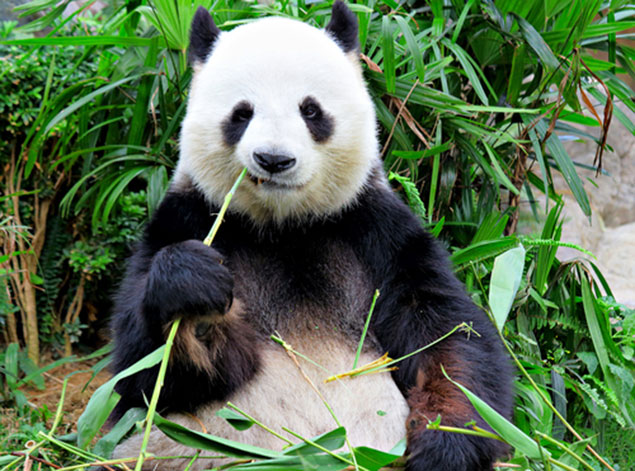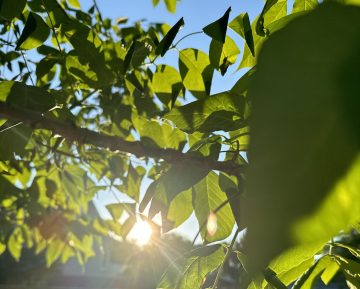
by Gord Grant PhD, RAc

Panda bears have it easy. A panda doesn’t need to make any food choices. They just eat bamboo — ALL day long. Oddly, a panda bear, like its bear cousins, has a complete omnivore-type digestive system, capable of handling an omnivore’s diet. Behaviourally though, they have evolved to only eat just bamboo. That’s their niche. They have special gut microbes they inherit from their mothers that can break down the wood-like cellulose of bamboo stalks and leaves.
Now we human omnivores, when it comes to food, make choices – many, many choices. Over the millennia, we have been challenged to survive by discovering what to eat and what NOT to eat. Our bigger brains are attributed to – at least in part – this omnivore’s nature of choosing. Before we were “civilized”, we survived (and often not) by being powerfully flexible – some people were completely vegetarian as gatherers of highly nutritious seeds, nuts, tubers, vegetables and fruits. They were likely also opportunists and scavengers that ate leftover kills from other more skilled predatory animals. Some people became excellent hunters and mainly meat-eaters. But most of us survived by being somewhere in the middle – eating what we could when it was in season, and as the opportunities presented. We lived by our wits, our knowledge passed down through the generations, to use our hands, our resources and tools, fire, and our abilities and capacity to work in teams to hunt, fish, gather, process, and preserve. Then we became farmers. We secured our food supply – nothing has been the same since! We have spanned and populated the globe into vastly different climates and terrains to adapt to various problems in feeding ourselves.
Over the years, we gradually yet remarkably changed the appearance of many food species – plants and animals alike – to better serve our needs of nutrition and supply. Domestication meant food sources that were tamer, bigger in size and yield, more uniform, more nutritious, and more responsive to being in rows and cages or in controlled, idealized, and optimized growth conditions. In fact, some animals and plants have changed so much they could not survive in the wild without us.
This miraculous transformation has taken place over a relatively short time. It has been the foundation of our capacity to create cities, institutions, and nations, and to explore every aspect of the natural world from subatomic particles to the far reaches of the cosmos. Food security has enabled a revolution in technology and communication, and shaped our sense of entitlement to freedom and prosperity.
We human omnivores have a NEW problem now — an epidemic of information and choices. “In the old days”, not long ago, we lived shorter lives due to infections and insecurity of food supply, and we just “died of old age”. But despite living longer than ever, we no longer are dying of old age. Our modern day afflictions are closely aligned with our addiction to excesses of lifestyle and diet. Contemporary diseases are rooted in excesses of fat, sugar, salt and stress, and deficiencies of basic whole food nutrients, exercise and sleep! It is a necessary stage of development I suppose. To me, this apparent surplus of food variety and quantity becomes a metaphor for the rest of our lives. Could the “what” and “why” we eat come to define each of us? I reflected in a previous blog about a time when there was ONLY organic and local food. These days we have more knowledge and access to information, yet science cannot simply and readily answer our most basic questions in ways we can understand. We are consumed by a variety of food terms which would have been unintelligible to our grandparents in their younger days: organic and local, dairy-free and sugar-free, low-fat and low-carb, vegetarian and vegan, gluten-free and wheat-free, super foods and medical foods, phytonutrients and nutraceuticals, RDA and RNI, paleo diet and raw food diet, preservatives and “functional ingredient additives”, slow vs. fast food, processed vs. unprocessed, and the most difficult one of all – natural vs. artificial! It goes on and on…how do we make sense of our food choices???
Here are a few guidelines I propose to make better sense of it all:
- Take wisdom from traditional diets before processed foods and fast-paced living. The suitability of certain combinations of whole foods and cooking methods have been time-tested.
- Take wisdom from conventional recommendations, in terms of guidelines for daily recommended intakes of food groups and nutrients. Although targeted to avoid primary nutritional pathologies and other diseases, it can be a great place to start.
- Never diet. I mean diet as in the new way of thinking, as a temporary strategy to lose weight. Diet as in the original meaning, referring to creating a sustainable lifestyle of how and what you eat in which your caloric intake is in balance with your energy expenditure.
- Trust your capacity to “listen” to your body before, during and after eating. Do you eat when you are hungry? Do you stop when you are full? Do you watch TV or browse on your computer or iPhone while eating (with others at the table?). . Paying more attention may even alert us to certain food sensitivities or intolerances that we can develop over time, especially to wheat, dairy, and nuts.
- Enjoy eating and become more engaged in both the experience of eating and in the preparation of your food. Invest in yourself – you’re worth it. Grow some of your food, just for fun – if you don’t have access to a garden space, then how about a couple of herbs in a sunny window? Take time to shop for food you like or the food you need, and plan your meals. Cook more meals at home using whole foods and fresh ingredients. Try cooking with less additives like salt, sugar and refined or processed foods. Socialize and eat with people you like and love; try to have more meals that take a longer time because you need to put down your fork in conversation. Even if it is just a hotdog purchased at a fast food joint.
I invite you to slow down, and have gratitude for this which gives you life. Learn to eat not just as the opportunity presents itself, but rather as a mindful navigation of the blessing (and curse!) of the many food choices offered to us in our modern society.




